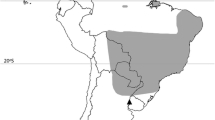Abstract
Visceral leishmaniasis is endemic in the southern part of the Terai region of Nepal. Natural infections of Phlebotomus species with Leishmania parasites in these endemic areas were analyzed by a polymerase chain reaction (PCR) amplification-based assay. A total of 401 Phlebotomus argentipes and 202 P. papatasi female sandflies were captured in the Dhanusa district from 2004 to 2006 and analyzed. It was found that 6.7% of P. argentipes, but no P. papatasi, were positive for Leishmania parasites, suggesting that P. argentipes is a major vector in these areas. The infectivity of P. argentipes with Leishmania was consistent with the infection rates reported from other areas of the world. This is the first report of naturally infected Leishmania parasites in sandflies collected from Nepal.



Similar content being viewed by others
References
Aransay AM, Scoulica E, Tselentis Y (2000) Detection and identification of Leishmania DNA within naturally infected sand flies by seminested PCR on minicircle kinetoplastic DNA. Appl Environ Microbiol 66:1933–1938
Basselin M, Badet-Denisot MA, Robert-Gero M (1998) Modification of kinetoplast DNA minicircle composition in pentamidine-resistant Leishmania. Acta Trop 70:43–61
Bettini S, Gramiccia M, Gradoni L, Atzeni MC (1986) Leishmaniasis is Sardinia: II. Natural infection of Phlebotomus pernicious Newstead, 1911, by Leishmania infantum Nicolle, 1908, in the province of Cagliari. Trans R Soc Trop Med Hyg 80:458–459
Choi CM, Lerner EA (2001) Leishmaniasis as an emerging infection. J Investig Dermatol Symp Proc 6:175–182
Cordoba-Lanus E, De Grosso ML, Pinero JE, Valladares B, Salomon OD (2006) Natural infection of Lutzomyia neivai with Leishmania spp. in northwestern Argentina. Acta Trop 98:1–5
Desjeux P (1996) Leishmaniasis. Public health aspects and control. Clin Dermatol 14:417–423
Dinesh DS, Kar SK, Kishore K, Palit A, Verma N, Gupta AK, Chauhan DS, Singh D, Sharma VD, Katoch VM (2000) Screening sandflies for natural infection with Leishmania donovani, using a non-radioactive probe based on the total DNA of the parasite. Ann Trop Med Parasitol 94:447–451
Gradoni L (2002) The diagnosis of canine leishmaniasis. Canine Leishmaniasis: moving towards a solution, Proceedings of the Second International Canine Leishmaniasis Forum Sevilla. Spain, pp 7–14
Hassan MM, Elraba’a FM, Ward RD, Maingon RD, Elnaiem DA (2004) Detection of high rates of in-village transmission of Leishmania donovani in eastern Sudan. Acta Trop 92:77–82
Kato H, Uezato H, Katakura K, Calvopiña M, Marco JD, Barroso PA, Gomez EA, Mimori T, Korenaga M, Iwata H, Nonaka S, Hashiguchi Y (2005) Detection and identification of Leishmania species within naturally infected sand flies in the Andean areas of Ecuador by a polymerase chain reaction. Am J Trop Med Hyg 72:87–93
Killick-Kendrick R (1999) The biology and control of phlebotomine sand flies. Clin Dermatol 17:279–289
Kumar V, Bimal S, Kesari S, Kumar AJ, Bagchi AK, Akbar MA, Kishore K, Bhattacharya SK, Das P (2005) Evaluation of a dot-immunoblot assay for detecting leishmanial antigen in naturally infected Phlebotomus argentipes (Diptera: Psychodidae). Ann Trop Med Parasitol 99:371–376
Lewis DJ (1987) Phlebotomine sandflies (Diptera: Psychodidae) from the oriental region. Syst Entomol 12:163–180
Maroli M, Gramiccia M, Gradoni L, Troiani M, Ascione R (1994) Natural infection of Phlebotomus perniciosus with MON 72 zymodeme of Leishmania infantum in the Campania region of Italy. Acta Trop 57:333–335
Ministry of Health, Nepal (2005/2006) Annual Report. Kala-azar Control. Kathmandu: His Majesty’s Government of Nepal, Ministry of Health, Directorate of Health Services, Epidemiology and Disease Control
Mukherjee S, Hassan MQ, Ghosh A, Ghosh KN, Bhattacharya A, Adhya S (1997) Short report: Leishmania DNA in Phlebotomus and Sergentomyia species during a Kala-azar epidemic. Am J Trop Med Hyg 57:423–425
Palit A, Bhattacharya SK, Kundu SN (2005) Host preference of Phlebotomus argentipes and Phlebotomus papatasi in different biotopes of West Bengal, India. Int J Environ Health Res 15:449–454
Pandey K, Yanagi T, Pandey BD, Mallik AK, Sherchand JB, Kanbara H (2007) Characterization of Leishmania isolates from Nepalese patients with visceral leishmaniasis. Parasitol Res 100:1361–1369
Ready PD, Smith DF, Kellick-Kendrick R (1988) DNA hybridization on squash-blotted sandflies to identify both Phlebotomus papatasi and infecting Leishmania major. Med Vet Entomol 2:109–116
Salotra P, Sreenivas G, Pogue GP, Lee N, Nakhasi HL, Ramesh V, Negi NS (2001) Development of a species-specific PCR assay for detection of Leishmania donovani in clinical samples from patients with Kala-azar and Post-Kala-azar dermal leishmaniasis. J Clin Microbiol 39:849–854
Smyth AJ, Ghosh A, Hassan MQ, Basu D, De Bruijn MHL, Adhya S, Mallik KK, Barker DC (1992) Rapid and sensitive detection of Leishmania kinetoplast DNA from spleen and blood samples of Kala-azar patients. Parasitology 105:183–192
Acknowledgements
We thank Mr. Shambhu Bahadur Shrestha, the entomology technician, for his help in collecting and identifying sandflies in the field. We also thank Dr. Richard Culleton for critically reading this manuscript. Kishor Pandey is supported by a scholarship from the Japanese Government Ministry of Education, Science, Sports and Culture (MONBUSHO). The present study was supported by the National Bio-Resource Project (NBRP) of MEXT, Japan.
Author information
Authors and Affiliations
Corresponding author
Rights and permissions
About this article
Cite this article
Pandey, K., Pant, S., Kanbara, H. et al. Molecular detection of Leishmania parasites from whole bodies of sandflies collected in Nepal. Parasitol Res 103, 293–297 (2008). https://doi.org/10.1007/s00436-008-0967-7
Received:
Accepted:
Published:
Issue Date:
DOI: https://doi.org/10.1007/s00436-008-0967-7




